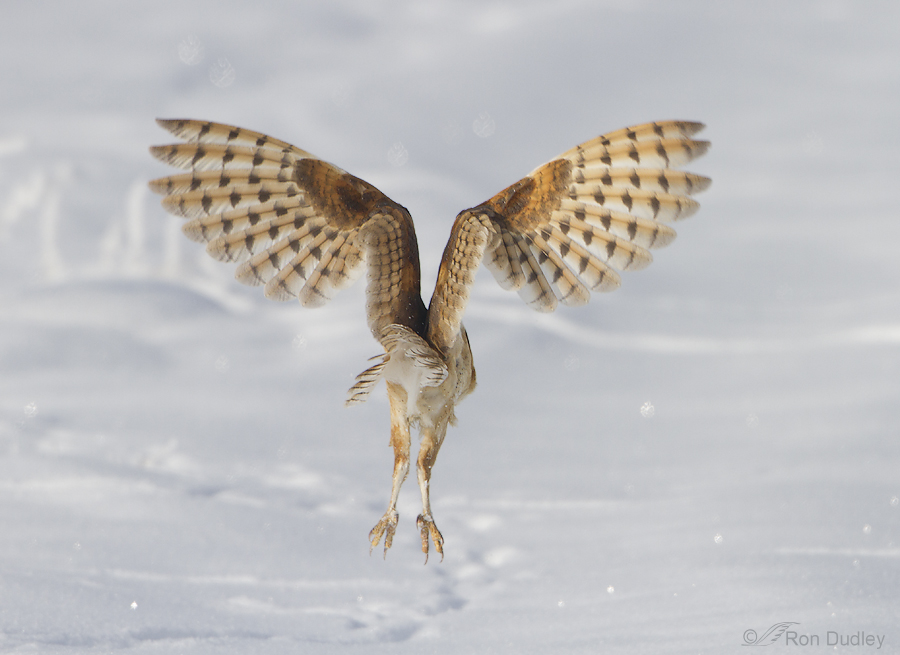This isn’t the sharpest image in my portfolio but it does intrigue me. A lot.
Six days ago this Barn Owl made an unsuccessful plunge into the deep snow for a vole and soon after took off almost directly away from me. This is one of the images I got as it lifted off in the direction of its favorite hill-top perch – a “butt shot” to be sure but I’m fascinated by the wing angle and position.

1/3200, f/7.1, ISO 500, 500 f/4, 1.4 tc, natural light, not baited, set up or called in
This shot caught the wings toward the end of the upstroke. The primary feathers at the end of the wings are in what appears to be an almost perfectly vertical position to allow for very little air resistance as they move to a higher position in preparation for the powered downstroke but the secondary feathers are pointed almost directly back at me.
The skeletal structure of a bird’s wing is homologous (similar in position, structure, and evolutionary origin but not necessarily in function) to the forelimb of most other vertebrates (including humans) with a humerus, then radius and ulna, then metacarpals and finally phalanges at the end. Like humans, the joint between the radius/ulna and the metacarpals is the carpal or “wrist” joint (see here if you’re curious and/or confused by the anatomy). So the “wrist” is the joint between the primary and secondary wing feathers.
Our wrist or carpal joint can be “bent” up or down and left or right but it cannot be rotated (try holding your lower arm in place with the other hand and then rotating your wrist). But it looks to me like this owl has rotated both “wrists” by almost 90 degrees (I’ve seen similar positions in Osprey photos). Which makes me wonder… HOW do they do that?
A little research suggests that the ability of birds to do so is the result of “the wedge-like shape of one carpal bone, the radiale” and that technical paper goes on to say that “the mobility of the wrist contributes to the ability of a flapping bird to partly fold the wing during the upstroke, greatly improving flight efficiency”.
By now I’ve probably belabored the point beyond the interest of many but I just couldn’t help myself – the “old biologist” in me coming out I guess…
But I suspect that most anyone can marvel at the beauty and functionality of a bird’s wing as illustrated by this photo.
Ron


Proprioceptors are also found in the stretch receptors located in the muscles and the joint-supporting ligaments (stance). Therapists test human’s proprioception by asking them to stand up with their feet together, first with their eyes open, and with their eyes closed. Persons with balance impairments are unable to keep balance with their eyes closed. This attests to the fact that proprioception is independent from light, temperature, pressure, or sound. It means that deaf frogs have been found to have good proprioception, and blind worms also. Deaf and blind people can also have good proprioception.
Very interesting stuff, Maria – in both of your comments. Thanks for including it.
I was able to follow you as I have medical background in occupational therapy. I think birds also rely heavily on “proprioception” which is the sense of the relative position of neighbouring parts of the body and strength of effort being employed in movement. The proprioceptive sense is believed to be composed of information from sensory neurons located in the inner ear. Besides gross and fine motor coordination from wings, claws, and beaks, birds also rely on these proprioception sense, although I don’t know a thing about zoology.
Great discussion. I’m a bit of an anatomy geek myself. My favorite topic with birds, I think, is the respiratory and vocal functions. So neat to see someone not just looking at his pictures because they look cool. Lots of things to think about.
” Lots of things to think about”.
So very true, Bryce – especially considering all of the adaptations for flight that birds have.
Bryce, a few years ago I attended a talk on bird respiration and I have to say, it was one of the most interesting lectures I’d heard in a long time. I didn’t know much of what was presented. I’m a sucker for information and information overload.
I don’t remember compelling visuals like this in biology class!
That’s because you weren’t in MY biology class, Mike
Your posts have been so wonderful lately…just want you to know I gain a lot by following them. Such amazing images and pertinent information. Thank you!
I appreciate your kind words, Teri. Thank you.
Fascinating information. I had a situation yesterday that had me wondering about bird anatomy as I watched a Great Blue Heron taking off from a floating position in deep water – something I’ve never observed before. That’s quite a mass to lift off, especially with the extra weight/drag of all those wet feathers. Anyhow, I’ll post in the next two days on the encounter between the GBH and a cormorant. Thank you for more perspective on how birds do the stuff they do!
Thanks, Wally. I’ll be watching for your post.
A truly beautiful “butt” shot. Thanks for the info on anatomy–it’s always appreciated.
Thank you, Sharon. I hope I didn’t take the “anatomy lesson” too far.